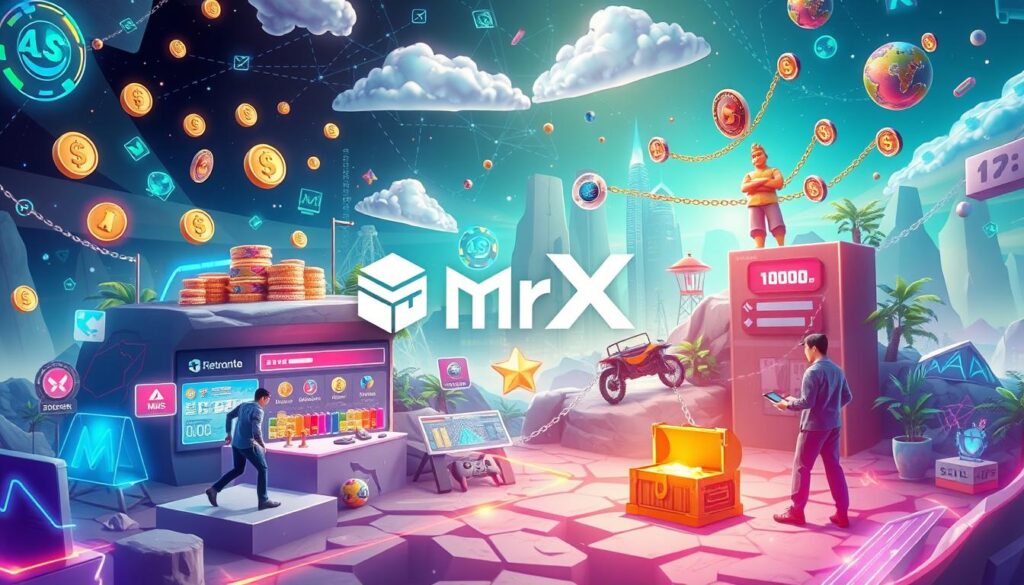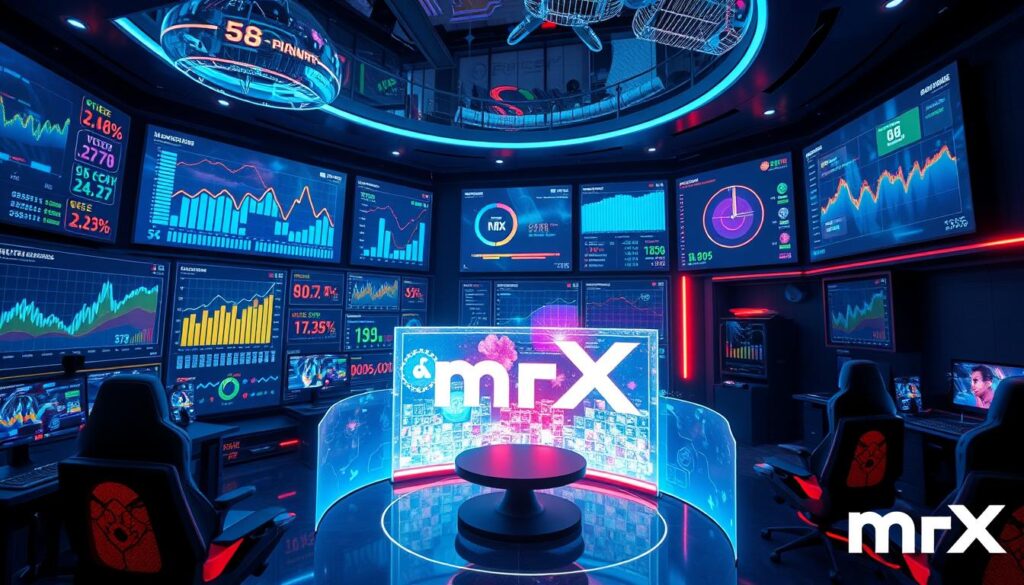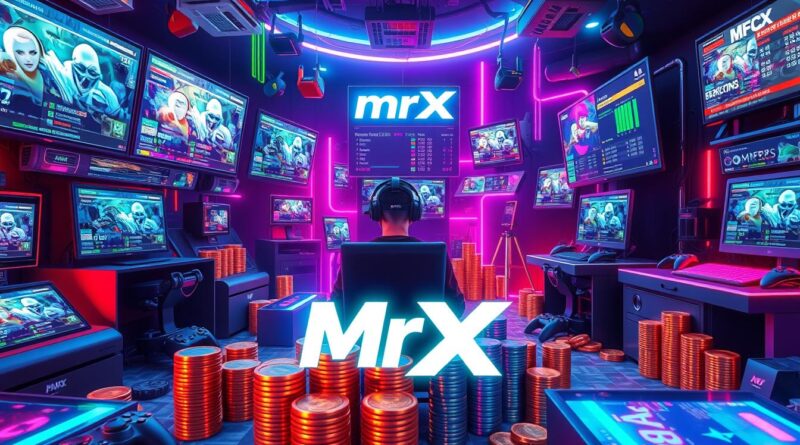How to Start Maximizing Earnings from Gaming Today
The world of gaming is unique, where passion and opportunity meet. For many, it’s more than just a hobby; it’s a source of creativity and excitement. What if you could turn your passion into profit?
The gaming industry is booming, with huge growth expected in the future. As we move forward, the chance to earn more from gaming is exciting. Imagine being part of a $180 billion industry in 2021. With eSports and new strategies, now is the perfect time to make money from your gaming.
Key Takeaways
- The gaming industry continues to grow rapidly, presenting substantial earning opportunities.
- Understanding market trends is crucial for maximizing earnings from gaming.
- Effective gaming strategies can significantly enhance revenue streams.
- Engaging in eSports can provide additional monetization avenues.
- Employing innovative monetization tips will refine your approach to revenue generation.
Understanding the Gaming Landscape
The gaming world has changed a lot, showing how *gaming trends* shape what players enjoy and how they make money. Looking at the gaming industry gives us a clear picture. It shows us how games are divided by type and where they are played.
Mobile gaming has grown a lot, attracting many different people. Knowing who plays games helps developers and marketers make better plans.
Players vary a lot, from those who just want to have fun to serious eSports fans. These differences affect *gaming trends* and how people act as gamers. This leads to new ideas in making games and finding ways to make money from them.
The world of gaming keeps changing, with new things players want and new tech. Staying up-to-date with these changes helps us find ways to make more money. People who invest, make games, and brands can use this knowledge to create games that appeal to many players.
Identifying Your Target Audience
Knowing your target audience is key to success in the gaming world. A deep dive into who your players are helps shape strategies that speak to them. This includes understanding their gaming habits, age, gender, and how much they spend.
Tools like surveys and analytics offer insights into who your players are and what they want. For instance, millennials and Gen Z are big spenders in gaming. This shows the importance of creating experiences that appeal to them.
Here’s an example showcasing different player personas:
| Player Persona | Age Group | Preferred Genres | Average Spending |
|---|---|---|---|
| Casual Gamer | 18-24 | Mobile Puzzles | $10/month |
| Hardcore Gamer | 25-34 | Action RPGs | $50/month |
| Social Gamer | 35-44 | Multiplayer Shooters | $20/month |
By getting to know your players better, you can make smarter choices in game development and marketing. Catering to different gaming groups not only improves the user experience but also boosts engagement and profits.
Maximizing Earnings from Gaming
Understanding what drives player behavior is key to making more money from gaming. Looking into player demographics and preferences gives us important clues. These clues help shape how games are made and marketed. By matching game features and ways to make money with what players like, developers can boost their earnings.
Importance of Player Demographics
Player demographics are vital in figuring out how much players spend and how engaged they are. Things like age, gender, and where they live affect how they play games and what they’re willing to pay for. For example, younger players often like buying small items in games, while older players might prefer bigger gaming experiences.
Understanding Player Preferences
Knowing what players like helps make games that they enjoy more. Surveys and looking at how players play can tell developers what works. Companies like Riot Games and Activision have made more money by listening to what players say. Creating a space where players can share their thoughts can really help increase earnings from gaming.
Game Monetization Strategies
Developers need to know about different ways to make money from games. Each method fits different types of games, helping developers meet their audience’s needs.
Exploring Various Models
There are many ways to make money from games. Each has its own good and bad points. Here are some common ones:
- Free-to-Play: This lets players start without paying, making money from in-game buys.
- Subscription-Based: Players pay a regular fee for special content, bringing in steady money.
- Pay-to-Play: Players pay once to get the full game, without needing to buy more.
Choosing the Right Model for Your Game
Picking the right way to make money is key. Things like the game type, who it’s for, and how to keep players interested matter a lot. Choosing a model that fits what players want can make them happier.

| Monetization Model | Advantages | Disadvantages |
|---|---|---|
| Free-to-Play | Wide player base, scalable revenue | Potentially aggressive in-game purchases |
| Subscription-Based | Stable revenue, committed player community | High churn rate if content is lacking |
| Pay-to-Play | Full price upfront, no ongoing costs | Limited initial audience, reliance on initial sales |
Looking at these models helps developers make smart choices. They can choose what fits best with what players like, while making money.
Leveraging In-Game Purchases Optimization
In-game purchases are key to many games’ success. By using smart pricing and offers, developers can boost sales and make players happy. Knowing how to price and offer items well is essential for making more money.
Best Practices for Pricing
Good pricing uses psychology. Charm pricing, like prices ending in .99, makes offers more attractive. Tiered pricing offers different levels at various prices, encouraging players to spend more.
For example, games might offer three in-game currency packs at different prices. This approach increases upsells and makes players feel they’re getting a good deal.
Creating Attractive Offers
Limited-time offers create urgency, making players buy faster. Bundling items or offering exclusive skins or characters boosts engagement and sales. For example, during events, games often release special packs or discounts on popular items.
When making offers, consider timing, exclusivity, and value. These elements are crucial for success.
| Offer Type | Description | Benefits |
|---|---|---|
| Limited-Time Promotions | Offers that expire after a set time frame. | Creates urgency, increasing immediate purchases. |
| Bundle Deals | Multiple items sold together at a discounted rate. | Encourages higher spending by providing perceived value. |
| Exclusive Skins/Items | Unique items available for a limited time. | Increases player loyalty and engagement. |
Designing Virtual Economies
Creating a good virtual economy is key for a game’s success. A well-structured economy keeps players interested and playing longer. By focusing on the core elements of economic balance, developers can make games that are fun and profitable.
Elements of Successful Virtual Economies
To build a strong virtual economy, you need a few important things:
- Currency: This is the heart of any economy, letting players buy, sell, and trade.
- Trade Mechanics: Create systems that make players want to trade more, boosting the economy.
- Scarcity: Make resources rare to add value and get players involved in the economy.
- Market Trends: Watch how players act to adjust the economy to meet their needs.
- Feedback Mechanisms: Use player feedback to improve the economy.
Balancing Supply and Demand
Keeping supply and demand in check is vital for economic balance. This means:
- Monitoring Player Engagement: Watch how players interact with the economy to understand demand.
- Adjusting Supply Rates: Change how much of in-game items or currency is available based on player activity.
- Implementing Feedback Loops: Use player insights to tweak the economy on the fly.
Games like Second Life and World of Warcraft show the value of good virtual economies. When done right, these strategies create a lively community and boost profits.
Implementing Player Engagement Techniques
Engaging players well needs a careful plan that uses different techniques. These methods help keep players coming back and boost revenue. Gamification, with its points, levels, and rewards, is key to keeping players interested.
Building a community is also vital. It makes players feel part of something and loyal. Try hosting events or challenges that bring players together. This makes the game better and strengthens friendships.
Looking at successful games can teach us a lot. For example, Clash of Clans keeps players hooked with its events and competitions. This shows how social features can make a game more exciting and loyal.
In the end, using gamification and community building is crucial. They keep players interested and help games thrive. This leads to lasting success in the gaming world.
Analyzing Game Performance with Game Analytics
Understanding how well a game performs is key to keeping players. Game analytics help developers see how players act and engage. This info helps make the game better and more profitable.
Key Metrics to Monitor
Tracking certain metrics gives deep insights into a game’s health. Here are some important ones:
| Metric | Description | Importance |
|---|---|---|
| Daily Active Users (DAU) | The number of unique users who engage with the game daily. | Shows how popular the game is and how well it keeps players. |
| Retention Rate | The percentage of players who return to the game after their first day, week, or month. | Shows how happy players are and if they keep playing. |
| Average Revenue Per User (ARPU) | The average income generated from each player over a specific period. | Measures how well the game makes money from each player. |
| Session Length | The average duration of a player’s gaming session. | Helps understand how long players stay and if the game is fun. |
| Player Churn Rate | The percentage of players who stop playing the game over a given timeframe. | Crucial for knowing why players leave and how to keep them. |
Game analytics tools help developers make smart choices. They can spot trends and areas to improve. This leads to better game updates and more player fun.

Exploring Free-to-Play Revenue Streams
The free-to-play model is very popular. It’s key for developers to look into different ways to make money. Strategies include in-game purchases, ads, and sponsorships, each offering unique chances to earn.
In-game purchases are a top way to turn free players into payers. Games like Candy Crush create fun content that makes players want to buy virtual items. This improves their game time. Big multiplayer games, like PUBG, use small transactions to let players customize their characters. This adds a personal touch.
Advertising is another big money maker. Ads are placed in games, helping to make money from free players. For example, rewarded ads give players in-game perks while earning money. Good ad formats help attract and keep players.
Sponsorships can also boost free-to-play games. By teaming up with brands that gamers like, games can offer special events or content. This draws in new players and keeps the current ones interested.
As free-to-play games grow in popularity, developers need to keep up with trends. They should always update their ways to make money. By engaging with the community and offering real value, developers can keep making money while giving players a great gaming experience.
Understanding Microtransaction Models
Microtransaction models are key in today’s gaming world. Players are more likely to buy things in games. It’s important for game makers and investors to know how these models work.
Knowing the different types of microtransactions helps. It gives insights into how players spend money and how it changes the game.
Differentiating Between Types of Microtransactions
There are three main types of microtransactions: cosmetic, pay-to-win, and convenience. Each type affects players differently.
- Cosmetic Purchases: These items, like skins or costumes, don’t change gameplay. They focus on looks and can make a lot of money without upsetting game balance.
- Pay-to-Win Purchases: These give players an edge. They can be divisive, as they can make some players feel left out.
- Convenience Purchases: These save time or make the game more enjoyable. They don’t change gameplay but affect how players play.
Looking at how players spend shows interesting trends. Games like Fortnite and Apex Legends make money from cosmetic items. Players like these items a lot.
The table below shows what players like about different types of microtransactions:
| Microtransaction Type | Player Reception | Average Spend |
|---|---|---|
| Cosmetic | Generally Positive | $5-$20 |
| Pay-to-Win | Mixed | $10-$50 |
| Convenience | Positive | $3-$15 |
Knowing about these models helps make better games. It also helps make more money without upsetting players.
Whaling Prevention Strategies
Whaling is when games target players who spend a lot, called “whales.” This practice is a big issue in mobile gaming. It’s important for developers to focus on keeping players safe and fair in their games.
One key strategy is to have clear prices. This way, players know what they’re getting into. It helps them avoid spending too much by surprise. Games should make it easy to understand what you’re buying.
Games should also be balanced. If players feel they’re getting value from playing, they won’t spend as much. It’s good to make games where you can enjoy them without spending a lot.
- Encourage player feedback on monetization practices.
- Implement spending limits or alerts to help monitor player spending.
- Provide diverse paths for progression that do not rely solely on purchases.
Some companies are doing great in stopping whaling. They use new ways to make money that are fair to players. By following their lead, we can make games that are fun and safe for everyone.
| Company | Strategy Implemented | Outcome |
|---|---|---|
| Supercell | Balanced in-game rewards and limited spending notifications | Increased player satisfaction and retention |
| Riot Games | Transparent pricing and diverse monetization options | Enhanced player loyalty and responsible spending |
| Epic Games | Community-driven feedback on in-game purchases | Improved player trust and engagement |
Ethical Monetization Practices
It’s key to have ethical ways to make money in the gaming world. This builds trust and happiness among players. Developers should be clear about in-game buys and loot boxes. This way, players know what they’re getting into.
This approach makes the game better and keeps players coming back. It’s all about keeping things fair and honest.
Game makers like Valve and Riot Games know how to do this right. They focus on what players want and can afford. They avoid tricks like too much advertising or unfair advantages for those who pay more.
Studies by the ESA show that being responsible with gaming is very important. The NPD Group’s reports say that players trust is key to how much they spend. When developers act ethically, they make more money and build a strong community.
This shows that being fair in making money is good for everyone. It’s not just about making more money; it’s about keeping players happy and loyal.
FAQ
What are the best strategies for maximizing earnings from gaming?
To earn more from gaming, use a mix of strategies. This includes optimizing in-game purchases and focusing on ethical monetization. Also, use data and analytics to improve your approach.
How can I optimize in-game purchases?
Optimize in-game purchases by setting prices that players like. Use tiered offers and limited-time deals to boost sales. Always listen to player feedback to understand their needs.
What are some effective player engagement techniques?
Boost player engagement with gamification and community events. Give players chances to connect and compete. This can include leaderboards and multiplayer challenges.
What should I know about virtual economies in gaming?
Successful virtual economies need good currency systems and balanced trade. Create value through scarcity and engage players in economic activities. This keeps players interested and boosts earnings.
How can I implement ethical monetization practices?
Be open with players and avoid unfair practices. Follow the lead of top game developers who focus on player well-being. Building trust and community is key to keeping players.
What are microtransaction models and their impact?
Microtransactions include cosmetic, pay-to-win, and convenience purchases. Know how players spend on these. Balance these transactions to keep gameplay fair and enjoyable.
What are the key metrics to monitor using game analytics?
Watch Daily Active Users, retention rates, and Average Revenue Per User. These metrics help improve gameplay and monetization strategies.
How can I analyze my game’s performance effectively?
Use game analytics tools to track important metrics. Monitor user engagement and conversion rates. This helps spot areas for improvement.
What are some popular revenue streams for free-to-play games?
Free-to-play games make money from in-game purchases, ads, and sponsorships. Target promotions and engaging content can turn free players into paying customers.
How can I prevent whaling in my game?
Prevent whaling by setting clear prices and ensuring fair gameplay. Offer tools for players to manage spending. This keeps monetization ethical.




